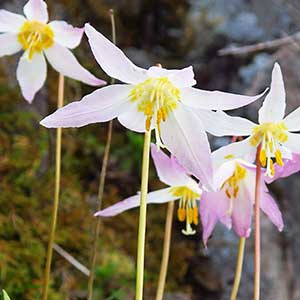Erythronium umbilicatum
Erythronium elegans
dimpled trout-lily
Coast Range fawn lily, elegant fawn-lily
ovoid, 10–25 mm;
stolons absent, or 1 per bulb on 1-leaved plants.
slender, 30–50 mm.
5–17 cm;
blade green, irregularly mottled, elliptic to ovate-lanceolate, ± flat, not glaucous, margins entire.
7–20 cm;
blade green or faintly mottled with brown or white, narrowly ovate, margins often wavy.
4–18 cm.
10–30 cm.
1-flowered.
1–2(–4)-flowered.
tepals strongly reflexed at anthesis, yellow, sometimes with brownish adaxial spots, variously tinged brown-purple abaxially, lanceolate, 13–30 mm, auricles absent;
stamens 9–18 mm;
filaments yellow, lanceolate;
anthers brown, purple, or infrequently yellow;
pollen brown, purple, or infrequently yellow;
ovary apex indented;
style deciduous or forming small apiculum, ± terete, not yellow, 8–24 mm;
stigma lobes spreading, 1.2–1.7 mm.
tepals: inner ± white, outer ± white and tinged (often strongly) with pink, especially abaxially and along midline, becoming more generally pinkish with age, both inner and outer with yellow band at base, lanceolate to narrowly elliptic, 20–40 mm, abaxial surfaces and outer tepals often darker, inner auriculate at base;
stamens 13–22 mm;
filaments white, flattened, slightly widened, linear to lanceolate, 0.8–2 mm wide;
anthers yellow;
style white, 10–20 mm;
stigma with slender, usually recurved lobes 2–4 mm.
± resting on ground due to reclining peduncle, obovoid, 10–22 mm, apex indented, umbilicate, or rarely rounded.
obovoid to oblong, 2–5 cm.
= 24.
= 48.
Erythronium umbilicatum
Erythronium elegans
Varieties 2 (2 in the flora).
(Discussion copyrighted by Flora of North America; reprinted with permission.)
Of conservation concern.
This species is endemic to the Coast Ranges of western Oregon.
(Discussion copyrighted by Flora of North America; reprinted with permission.)
1. Stolons absent; West Virginia to Alabama, Georgia, and n Florida. | subsp. umbilicatum |
1. Stolons present, 1 per bulb; North Carolina, Tennessee. | subsp. monostolum |


